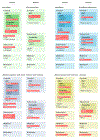Brain circuit dysfunction in post-traumatic stress disorder: from mouse to man
- PMID: 30054570
- PMCID: PMC6148363
- DOI: 10.1038/s41583-018-0039-7
Brain circuit dysfunction in post-traumatic stress disorder: from mouse to man
Abstract
Post-traumatic stress disorder (PTSD) is a prevalent, debilitating and sometimes deadly consequence of exposure to severe psychological trauma. Although effective treatments exist for some individuals, they are limited. New approaches to intervention, treatment and prevention are therefore much needed. In the past few years, the field has rapidly developed a greater understanding of the dysfunctional brain circuits underlying PTSD, a shift in understanding that has been made possible by technological revolutions that have allowed the observation and perturbation of the macrocircuits and microcircuits thought to underlie PTSD-related symptoms. These advances have allowed us to gain a more translational knowledge of PTSD, have provided further insights into the mechanisms of risk and resilience and offer promising avenues for therapeutic discovery.
Conflict of interest statement
Competing interests
K.J.R. is on the scientific advisory boards for Resilience Therapeutics, the Sheppard Pratt-Lieber Research Institute, the Laureate Institute for Brain Research, the Army Study to Assess Risk and Resilience in Servicemembers (STARRS) project, the University of California-San Diego VA Center of Excellence for Stress and Mental Health (CESAMH) and the Anxiety and Depression Association of America; provides fee-for-service consultation for Biogen and Resilience Therapeutics; and holds patents for the use of d-cycloserine and psychotherapy, targeting the pituitary adenylate cyclase-activating polypeptide (PACAP) type 1 receptor for extinction, targeting tachykinin 2 for prevention of fear and targeting angiotensin to improve extinction of fear. R.J.F., L.A.M.L. and J.S. declare no competing interests.
Figures



References
-
- Morris DJ The Evil Hours: A Biography of Post-Traumatic Stress Disorder. (Houghton Mifflin Harcourt, 2015).
-
- van der Kolk B Interview: what is PTSD really? Surprises, twists of history, and the politics of diagnosis and treatment. Interview by Lisa M Najavits. J. Clin. Psychol 69, 516–522 (2013). - PubMed
-
- American Psychiatric Association. Diagnostic and statistical manual of mental disorders (DSM-3). (APA Publishing, 1980).
-
- Insel T et al. Research domain criteria (RDoC): toward a new classification framework for research on mental disorders. Am. J. Psychiatry 167, 748–751 (2010). - PubMed
Publication types
MeSH terms
Grants and funding
LinkOut - more resources
Full Text Sources
Other Literature Sources
Medical
Miscellaneous

